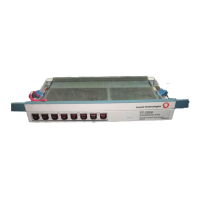Maintenance Description
9-8 Issue 8.0 July 2002
Fault Detection, Isolation, and Reporting 9
The FT-2000 OC-48 Lightwave System continuously monitors its internal
condition and incoming signals according to the state of the circuit pack slots and
low-speed ports. (For information about circuit pack slot and low-speed port states
and transitions, refer to Volume I, Section 8, "Administration and Provisioning.") If
a circuit pack slot is in the EQ state, the FT-2000 OC-48 Lightwave System
monitors the circuit pack and activates the appropriate indicators when a failure
occurs. Table 9-1 shows the incoming signals and the associated conditions the
FT-2000 OC-48 Lightwave System monitors.
When a trouble condition is detected, the FT-2000 OC-48 Lightwave System
employs automatic diagnostics to isolate the failed circuit pack or signal. Most
faults are isolated to a maximum of two circuit packs, but some faults may be
isolated to more than two circuit packs. Failures are reported to the local
technician and operations systems so that repair decisions can be made. If
desired, operations system personnel and the local technician can use the CIT to
gain more detailed information on the trouble condition.
All trouble conditions detected and isolated by the FT-2000 OC-48 Lightwave
System are stored and made available to be reported, on demand, through the
CIT. In addition, a history of the past 125 alarm and status conditions and CIT
events is maintained and available for on-demand reporting. In Release 4 and
later releases, the FT-2000 OC-48 Add/Drop-Rings Terminal maintains the past
500 alarm and status conditions and CIT events. The CIT events include condition
starting events, condition clearing events, autonomous actions by the system, and
user actions. Each event is date and time stamped.
NOTE:
Any reset of the FT-2000 OC-48 Add/Drop-Rings Terminal erases the alarm
history file (the past 500 alarm and status conditions and CIT events).
The FT-2000 OC-48 Lightwave System also automatically reports all detected
alarm and status conditions and CIT events through indicators that are subject to
the provisionable incoming signal alarm delay and through indicators that are
not
subject to incoming signal alarm delay.

